This post contains affiliate links. Please see our disclosure policy.
These 10 gentle and effective chair exercises for seniors will help improve strength and flexibility while seated, creating an ideal low-impact workout for any age.
Seated chair exercises for seniors provide a safe and accessible workout option that can still be challenging and deliver results. For example, if you get too wobbly on your feet trying to curl a set of dumbbells, a seated option may be more comfortable for you.
You can still work your core and other muscles while seated. Sitting down while you exercise will help reduce your rate of falling, and avoid other exercise related injuries.
Whether you have lower body mobility issues or just prefer exercising in a seated position, these body chair exercises can help you maintain regular exercise and promote overall well-being. They will also help keep your heart healthy, bones and muscles strong, weight under control, and mood at optimal levels.
Right below you’ll find my low-impact workout circuit with 10 chair exercises for seniors designed specifically with safety in mind. Grab a sturdy chair and get started.
Exercise is crucial for maintaining a healthy lifestyle, regardless of age, and it’s never too late to start!
Seated Exercise Workout Instructions:
- Grab a set of dumbbells at a weight that feels comfortable to you.
- Complete each exercise with a single set of 10 repetitions.
- Aim to complete the full circuit of exercises 2-3 time per week.
- If you are a beginner, start with five repetitions for each exercise, and work your way up!
Try these 10 seated exercises for a low-impact way to get your resistance training done:
1. Seated Side Bends
This seated side bend exercise will engage your oblique muscles, stretching and improving lateral flexibility.
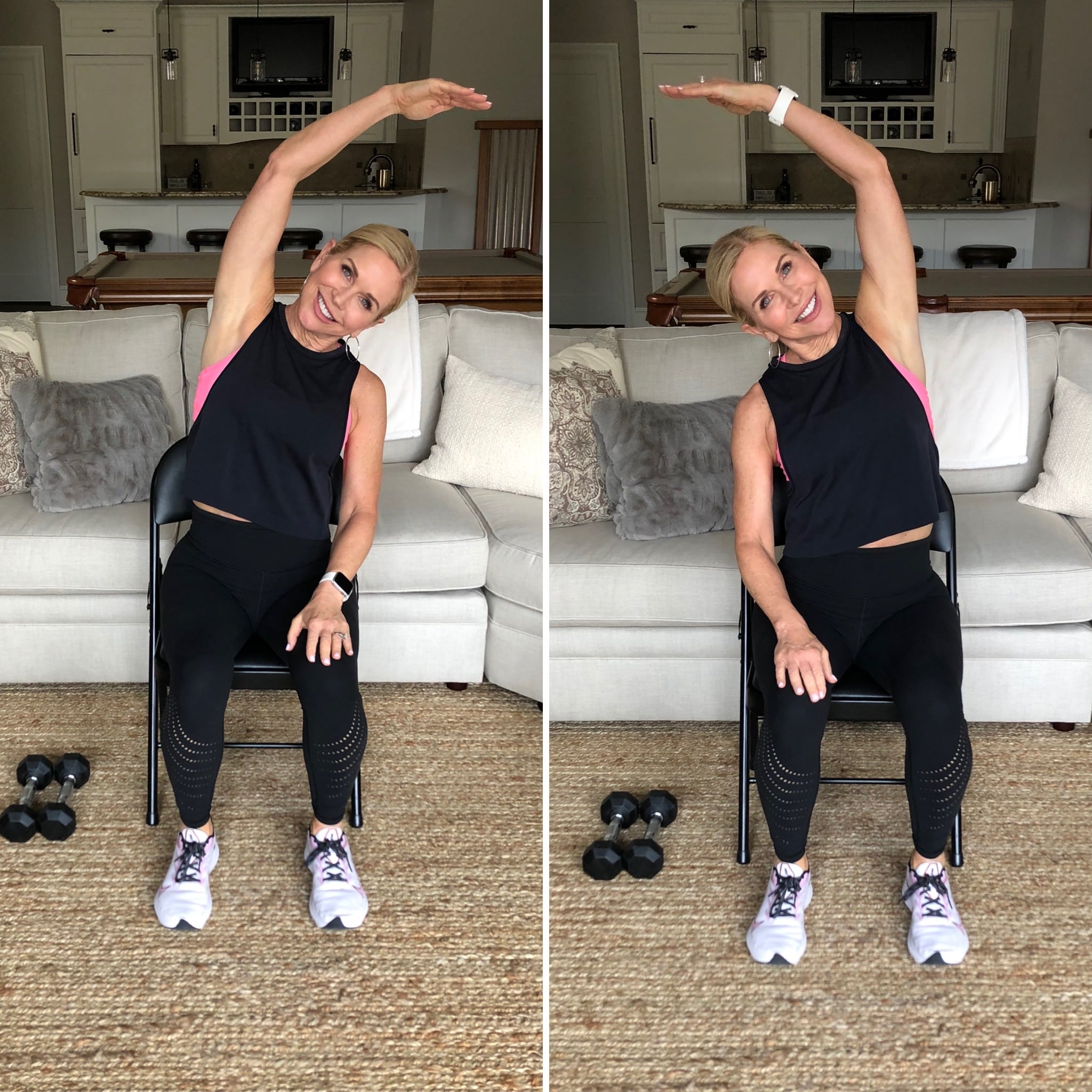
How to Perform a Seated Side Bend:
- Sit in a chair with knees bent and feet flat on the ground. Bend your right arm to bring your right hand to the right side of your head. Allow your left arm to hang at your side. Keep an upright posture; don’t slouch or lean back in the chair.
- Inhale. As you exhale, bend gently at the waist to lower your left arm toward the floor. Keep your chest open and pull your right elbow back to feel a stretch in your right side.
- Inhale to return to starting position.
- Repeat on the other side.
Muscle Groups Targeted: Internal and External Obliques
2. Seated Calf Raises
The seated calf raise exercise lifts your heels off the ground, targeting the gastrocnemius and soleus muscles for strengthening and tightening.

How to Perform a Seated Calf Raise:
- Sit tall on a chair with your feet flat on the ground.
- Lift your heels off the ground until you feel a squeeze in your calves.
- Slowly lower your heels back down and repeat.
- To make the exercise harder, balance a dumbbell on the top of each knee.
Muscle Groups Targeted: Calves
3. Seated Single-Leg Extensions
This seated single-leg extension exercise will engage your quadriceps muscles while maintaining stability and control.
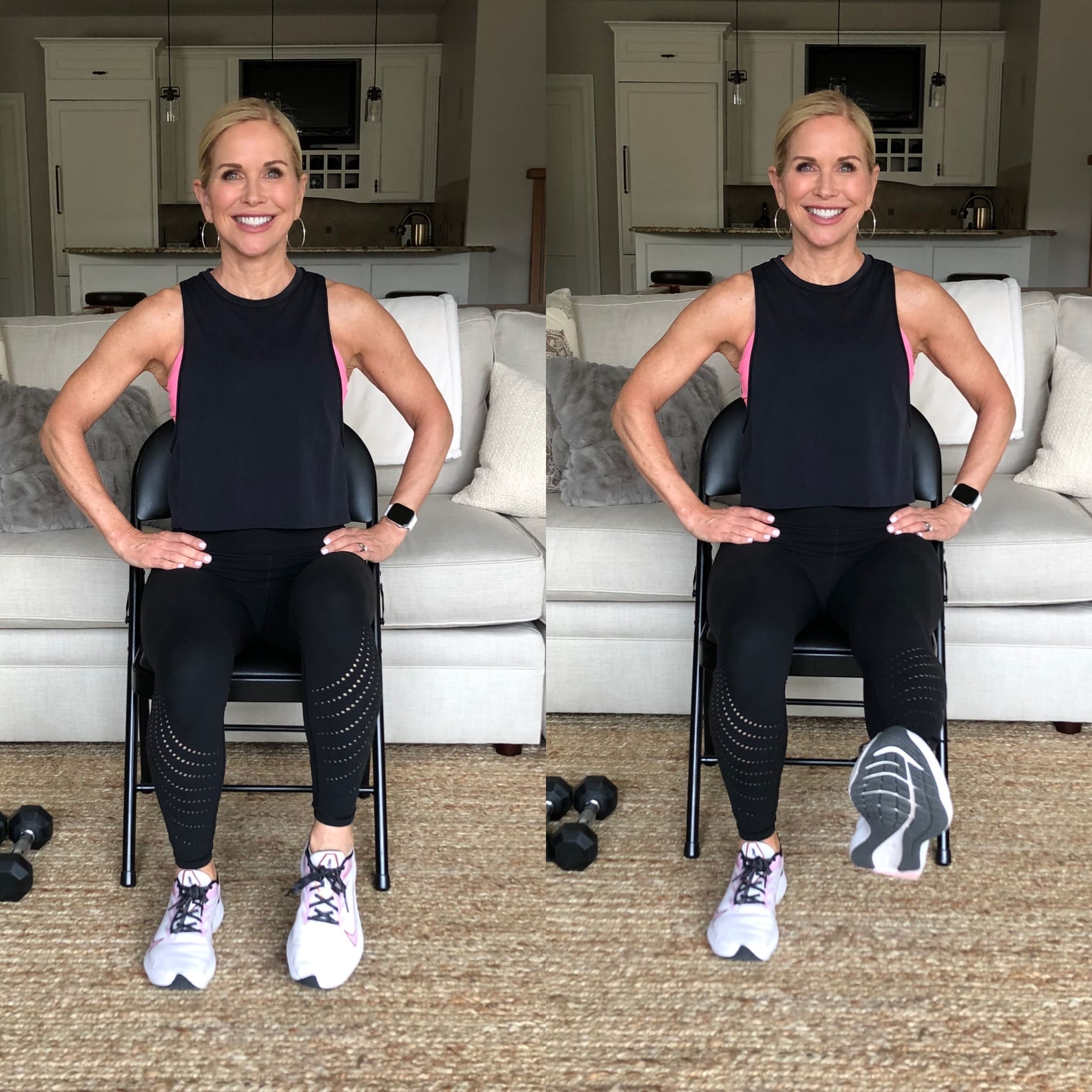
How to Perform a Seated Single-Leg Extension:
- Sit tall in a chair with your feet flat on the ground and grasp the sides of the seat.
- Keeping one foot planted and your upper body fixed, extend your opposite leg until it’s parallel to the floor.
- Bend your knee to return your foot to the ground. Repeat for the desired number of reps. Then switch to the other leg.
Muscle Groups Targeted: Quads, Hamstrings, Abdominals
4. Seated Knee-to-Elbow
This seated knee-to-elbow exercise is a clever way to work your abdominals and obliques for strengthening and toning.
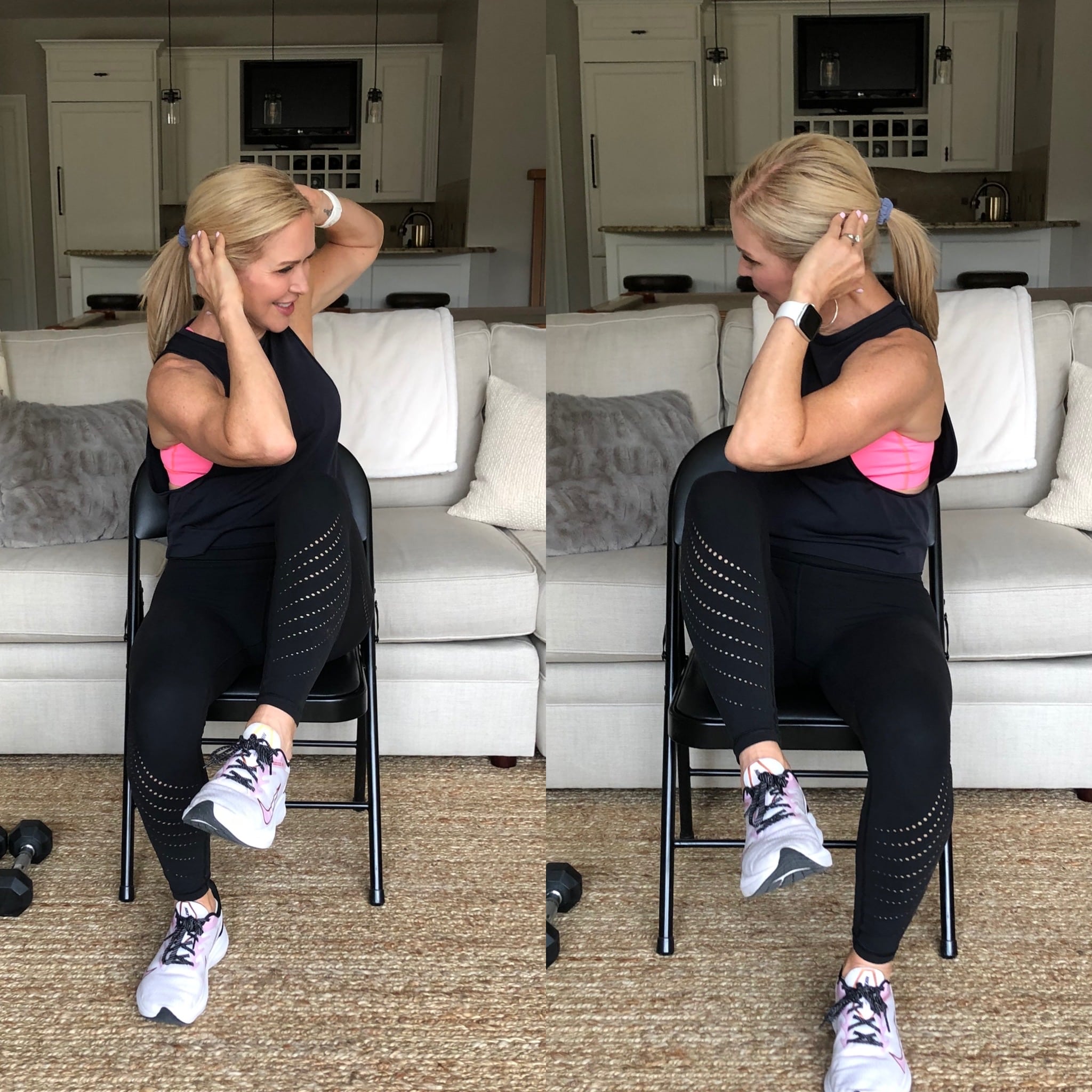
How to Perform a Seated Knee-to-Elbow:
- Sit in a chair with both feet flat on the ground. Clasp your hands behind your head, elbows wide.
- Twist your upper body to the right and lift your right knee to tap your left elbow.
- Return to the starting position and twist to the left to repeat the movement on the opposite side. Continue for reps.
Muscle Groups Targeted: Rectus Abdominis, Obliques, Quads, Hamstrings
5. Chair Squats
The chair squat exercise is an effective way to target your quadriceps, hamstrings, and glutes, while still providing stability and support.
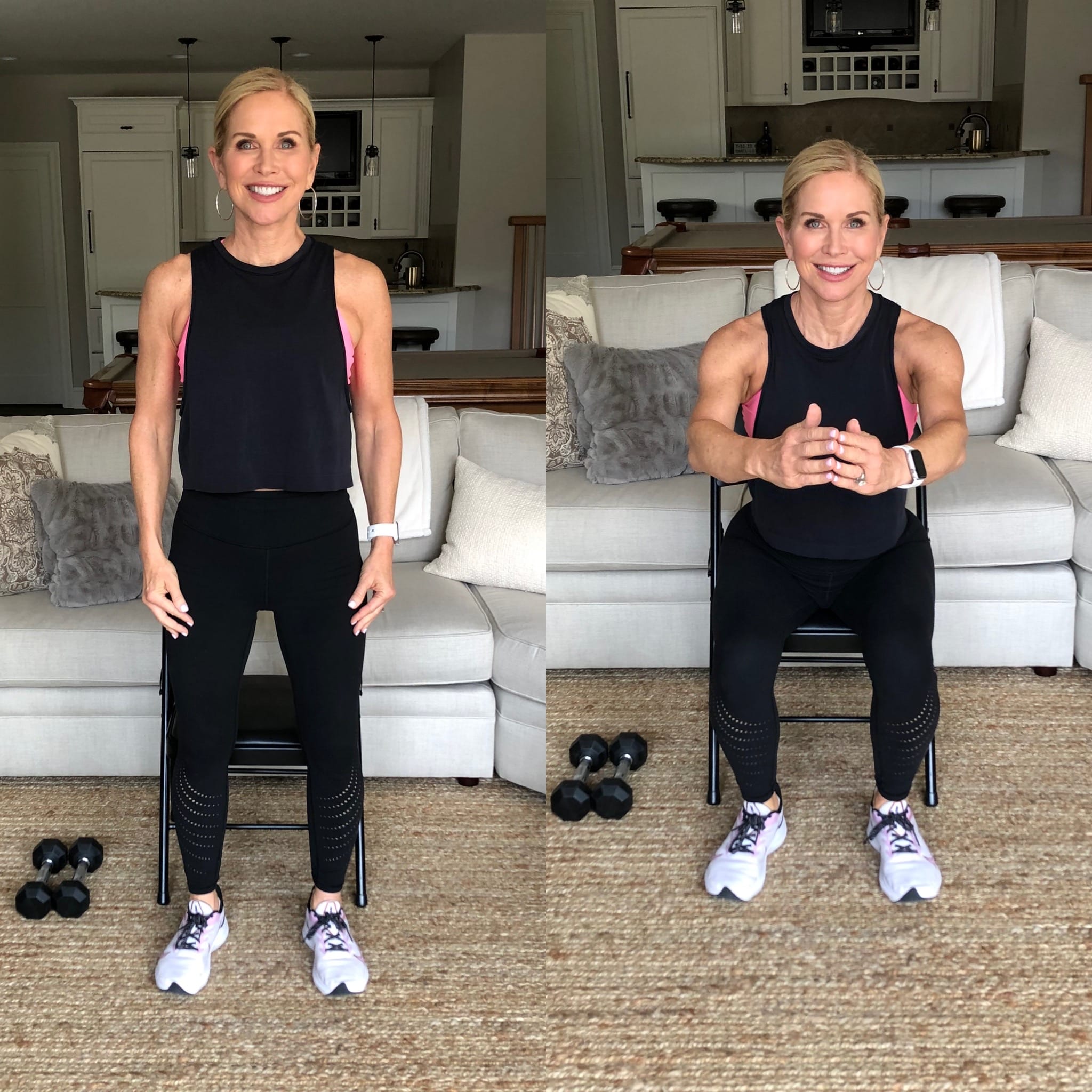
How to Perform a Chair Squat:
- Stand directly in front of your chair, facing away from it with feet shoulder-width apart and toes pointing forward.
- Keeping your chest lifted, bend your knees to sit your hips down and back. Gently tap the chair with your butt.
- Push yourself back up to the starting position. Repeat.
Muscle Groups Targeted: Quads, Glutes, Hamstrings
6. Seated Dumbbell Biceps Curls
This seated dumbbell bicep curl exercise targets your bicep muscles to build arm strength and definition.
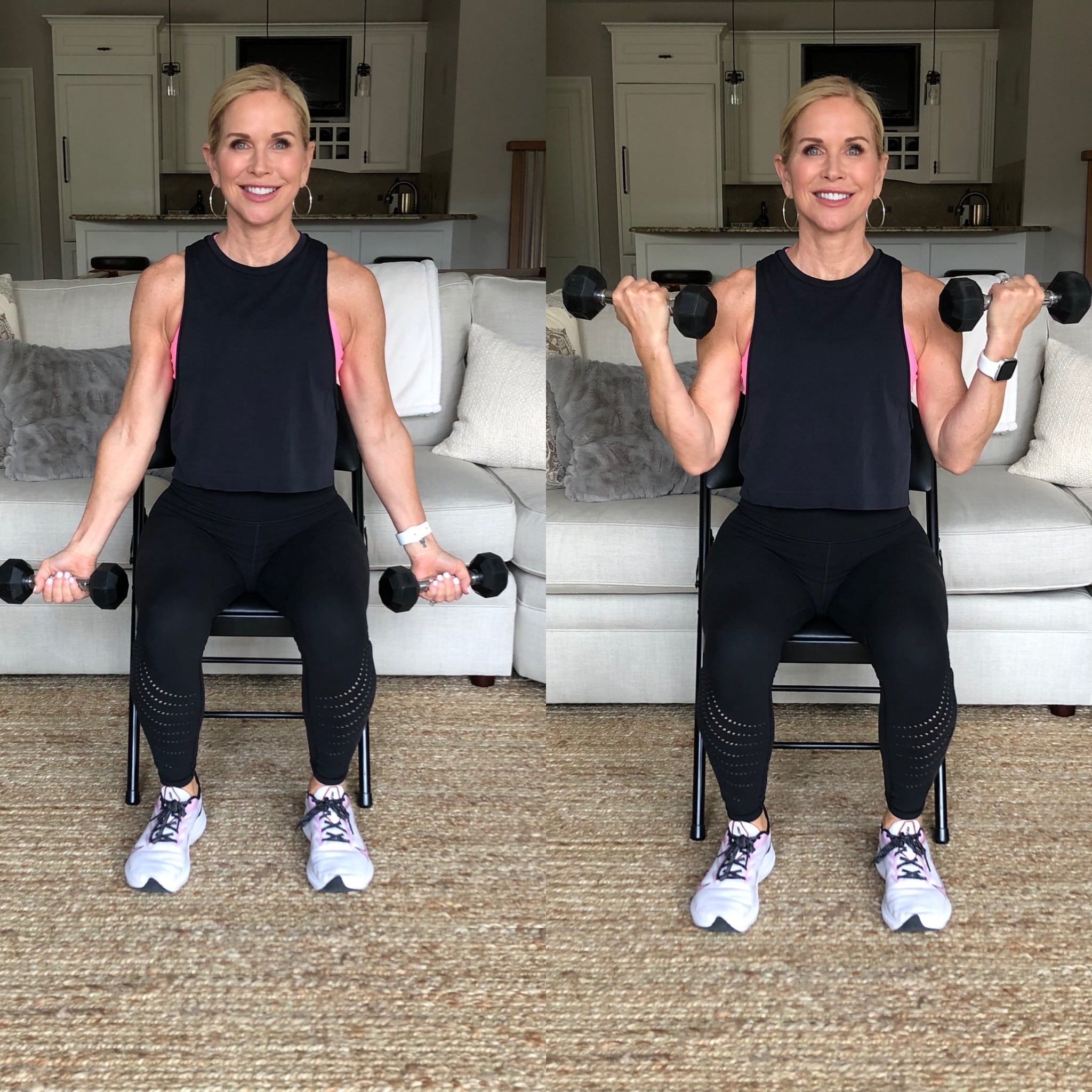
How to Perform a Seated Dumbbell Bicep Curl:
- Sit tall in a chair and hold a dumbbell in each hand. Let them hang at arm’s length by your sides, palms facing forward.
- Keeping your arms tight against your sides, bend your elbows to curl the dumbbells up to your shoulders.
- Lower the weights back down until your arms are straight again. Repeat.
Muscle Groups Targeted: Biceps, Abdominals
7. Seated Dumbbell Overhead Shoulder Presses
This seated dumbbell overhead should press exercise strengthens and sculpts the deltoids while stabilizing your core.

How to Perform Seated Dumbbell Overhead Shoulder Press:
- Sit tall in a chair. Lift your elbows out to the side to create a goal post position with your arms, dumbbells on either side of your head.
- Tighten your abdominals and press the dumbbells up slowly until your arms are straight.
- Slowly return to the starting position with control. Repeat for the desired number of reps.
Muscle Groups Targeted: Shoulders, Biceps, Abdominals
8. Seated Dumbbell Rows
The seated dumbbell row exercise will engage your back muscles while retracting your shoulder blades and strengthening your upper back.
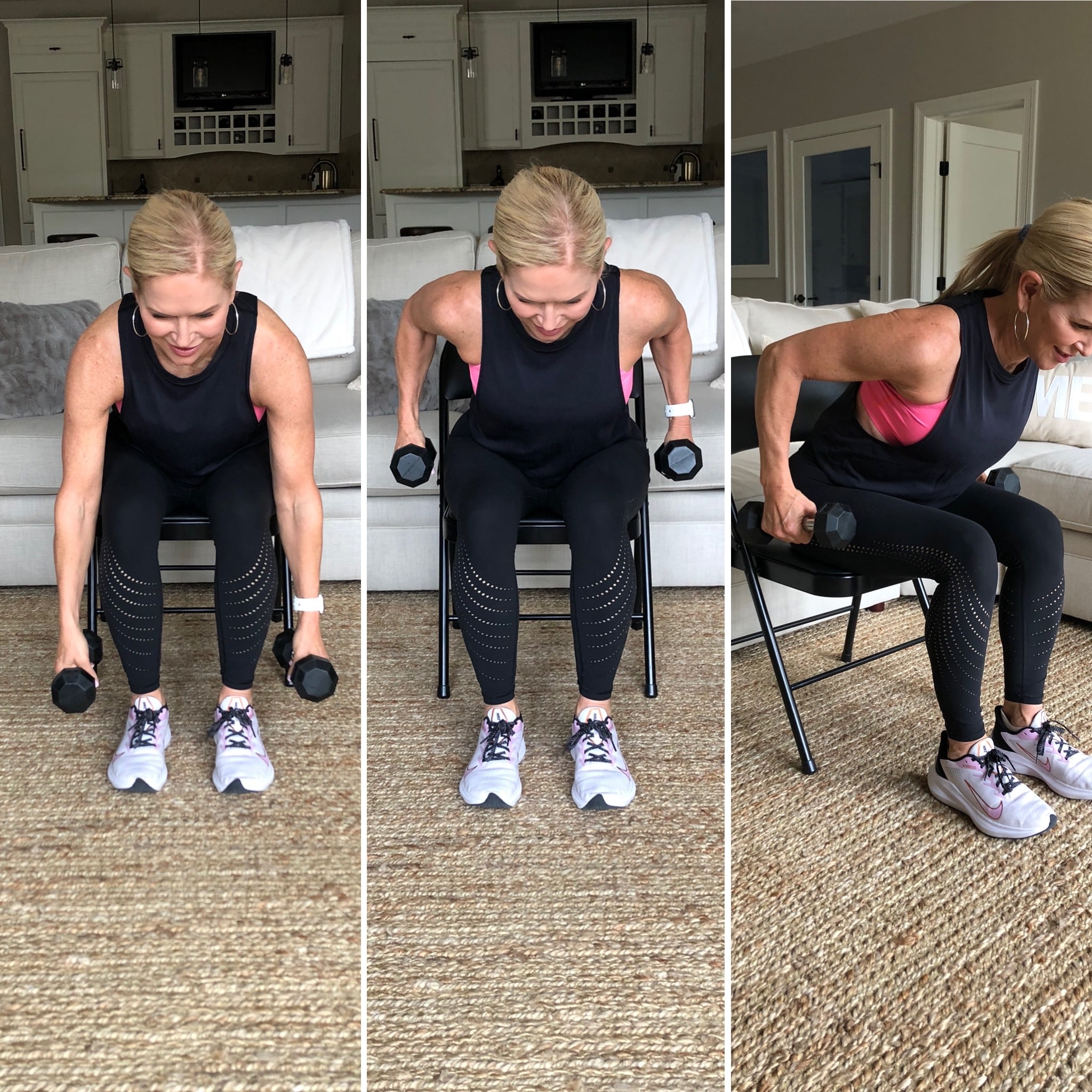
How to Perform Seated Dumbbell Rows:
- Sit in a chair. Hold a dumbbell in each hand down by your sides with palms facing each other.
- Bend slightly forward at the hips. Keeping your elbows close to your body, squeeze your shoulder blades together and drive your elbows back until your upper arms are nearly parallel to the floor.
- Slowly return to the starting position with control. Repeat.
Muscle Groups Targeted: Upper Back, Shoulders, Abdominals
9. Seated Dumbbell Triceps Kickbacks
This seated dumbbell tricep kickback exercise works to strengthen and tone your tricep muscles in the back of your arms.
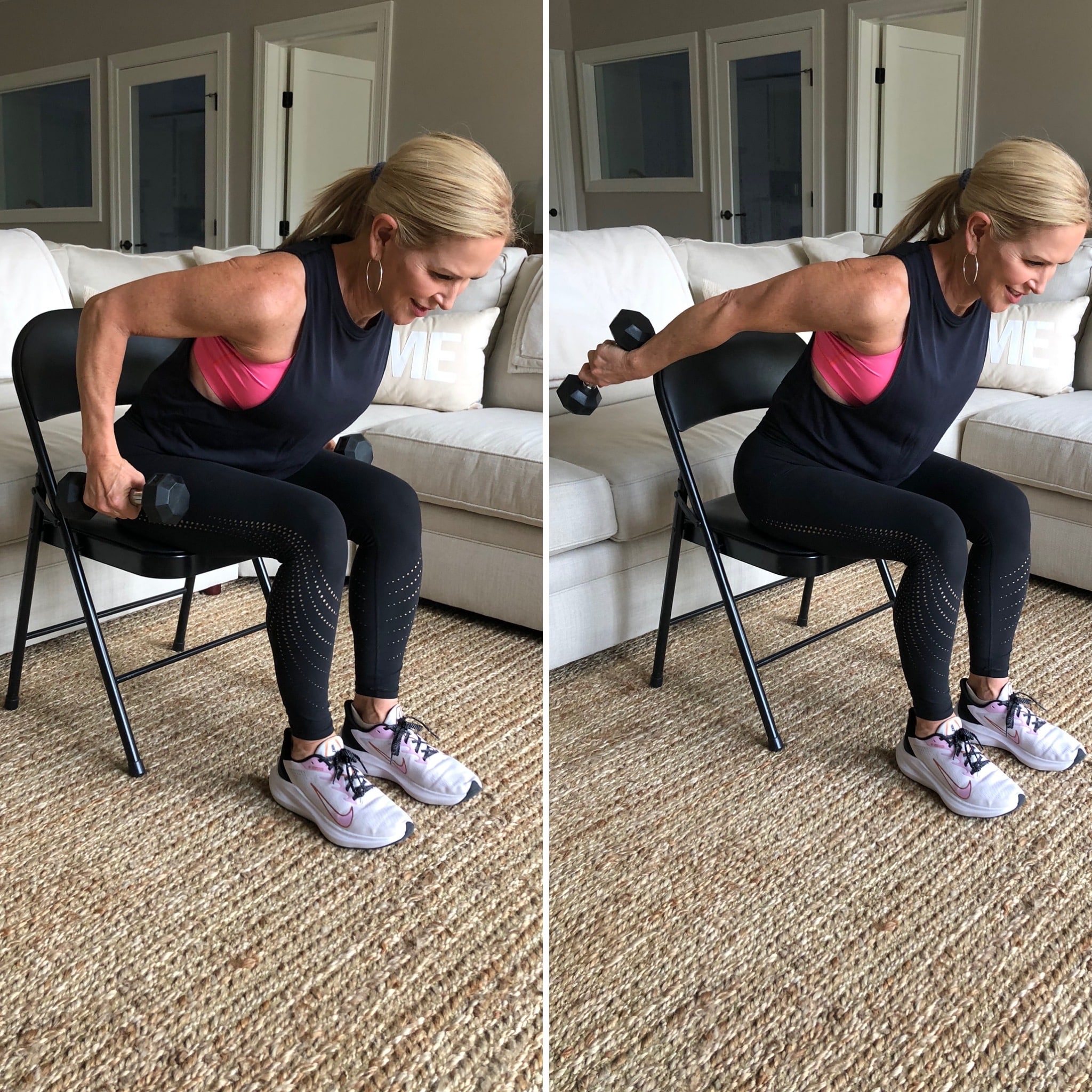
How to Perform Seated Dumbbell Tricep Kickbacks:
- Sit in a chair and lean forward until your chest is almost parallel to your thighs, with arms bent at 90-degree angles, and dumbbells to the sides of your chest.
- Keeping your back flat and elbows hugging your sides, press both dumbbells back until your arms are straight.
- Return the arms back to a 90-degree angle with control. Repeat.
Muscle Groups Targeted: Triceps, Shoulders, Upper Back
10. Seated Forward Roll-ups
The seated forward roll-up exercise promotes spinal flexibility while building abdominal strength.

How to Perform a Seated Forward Roll-Up:
- Sit in a chair with your legs extended, heels on the floor, and feet flexed towards your face. Extend your arms in front of you. Keep an upright posture; don’t slouch or lean back in the chair.
- Begin curling your chin to your chest. Exhale as you roll the entire torso up and over, keeping your legs straight, and abs engaged. Reach down towards the toes.
- Once you can’t reach any further, inhale as you begin to roll back up to the starting position, one vertebra at a time.
- Repeat moving slowly. Avoid using momentum; try to use your abdominals to lift and lower.
Watch the Full Seated Chair Exercises for Seniors Workout
Benefits of Seated Chair Exercises for Seniors
Chair exercises are an excellent way for seniors to stay active, no matter their ability. Not only are these exercises safe and low-impact, but they also provide a range of benefits for overall wellness.
From improved strength, flexibility, and balance to better blood circulation, there are many benefits of chair exercises for seniors.
Here are just a handful of the perks of using this exercise for seniors:
Chair Exercises are More Accessible
Standing exercises can be risky if your balance or mobility is less-than-great. While it’s important to practice standing exercises to improve your balance and mobility, you may need a safer movement option if you’re exercising by yourself or just starting to lift weights.
Seated exercises allow you to reap the benefits of resistance training without fear of falling down and breaking a bone. They are a great option for individuals with limited mobility.
Build Lean Muscle
The sad truth is most of us lose 25% of our valuable muscle mass by our 70th birthday. Thankfully, seated exercises are one of your best options for rebuilding any lost muscle — especially if they incorporate resistance bands or dumbbells for a fuller body workout.
You can try any of my favorite home gym products for seniors from Amazon.
And adding muscle will make everyday life a lot easier, from carrying heavy bags to getting up without having to use the back of the chair.
Increase Blood Circulation
Seated exercises wake up your muscles and other tissues, moving blood and other fluids through your limbs in the process. Boosting blood flow is a big deal, especially as we get older and more sedentary.
Strength training will also challenge your heart, which helps to improve cardiovascular health.
Chair Exercises for Seniors Improve Joint Health
Moving your limbs as you lift weights encourages your joints to self-lubricate. Seated exercises will go a long way toward improving range of motion and reducing stiffness and other joint soreness.
Remember, motion is lotion!
Prevents Bone Fractures
Osteoporosis — and the broken bones that go with it — is a common symptom of aging. Whether it’s your left leg, right leg, left foot, or right foot, something is bound to happen without preventative movement.
By challenging your muscles through seated exercises, you can build greater bone strength, which may prevent painful fractures.
Overall, chair exercises are an excellent way for seniors to maintain their physical health and stay active. You can even try chair yoga!
By incorporating these exercises into their routine, seniors can improve their strength, flexibility, and balance while reducing the risk of falls and joint pain.
Can You Lose Belly Fat Doing Chair Exercises?
It’s not uncommon to pack on a few pounds around your midsection as you age. You can blame a slowed metabolism and decrease in energy-burning muscle tissue.
Aside from the annoyance that carrying extra weight can bring, it also increases your risk of chronic illnesses like diabetes and heart disease.
Seated exercises — like the ones below — may help you lose those extra pounds. Just make sure you do them consistently to see maximum benefits. Try to work hard enough to get your heart pumping during the exercises.
Getting Started with Chair Exercises for Seniors
Starting chair exercises, or anything new, can seem daunting. But don’t worry, this workout is simple and accessible. It’s a great way to get back into moving.
Here are some beginner-friendly tips to help you get the most out of your seated workouts:
Choose the Right Chair
For seated exercises, you’ll need a sturdy, stable chair without wheels. Look for a chair with a straight back and a firm seat.
Avoid chairs with arms as they can limit your movement.
A few options include:
- Folding Chair (easy storage, but make sure to choose a sturdy one)
- Dining Chair (sturdy and avoid a super cushioned seat)
- Office Chair (be careful of wheels, make sure they lock in place)
Maintain Proper Posture
When doing seated exercises, maintaining proper posture is crucial. Sit up straight with your feet flat on the ground and your hands resting on your thighs.
Keep your shoulders relaxed, and your chin parallel to the floor. Avoid hunching forward or arching your back.
Warm Up Before You Begin
Before starting, spend a few minutes warming up your muscles. You can do some gentle stretches or march in place to get your heart rate up.
This prepares your body for exercise and helps to prevent injury.
By following these simple tips, you’ll be ready to start your chair exercises below and enjoy the numerous benefits they offer.
Conclusion
As we have seen, incorporating chair exercises into a senior’s daily routine can have numerous benefits for their well-being. Not only do these exercises improve strength, flexibility, and balance, but they also promote good cardiovascular health and alleviate joint pain.
Seated workouts are accessible, safe, and can be done from the comfort of a chair, making them an ideal choice for seniors with mobility issues.
Regularly practicing these exercises can help seniors maintain independence in their daily activities and lead an active lifestyle. Whether you’re a beginner or an experienced exerciser, there are many chair exercises tailored to different needs and fitness levels.
So why not try incorporating these safe and easy seated exercises into your routine and see the difference they can make in your life!



Great. I love this Blog, Now I can workout in my house easily.
Love your chair exercises for seniors.
Thank you for sharing this. I will do this for my health as a senior
.
I am new to the GetHealthyTV program and my husband saw me doing a workout his morning. He asked if there were any with men as the leaders specifically for golf stretches. Are there currently or will there ever be “mens” workouts led by men?
well we’ve been in business for over 10 years – the mission to help mid life women – so no programs for men. I know it would be nice but hard to do it all! :-)!! THanks for working out with us!
I have looked at dozens of sites for seniors and this is by far the best one I’ve found.
So easy to follow and uses numerous muscle groups.
oh thank you !!!